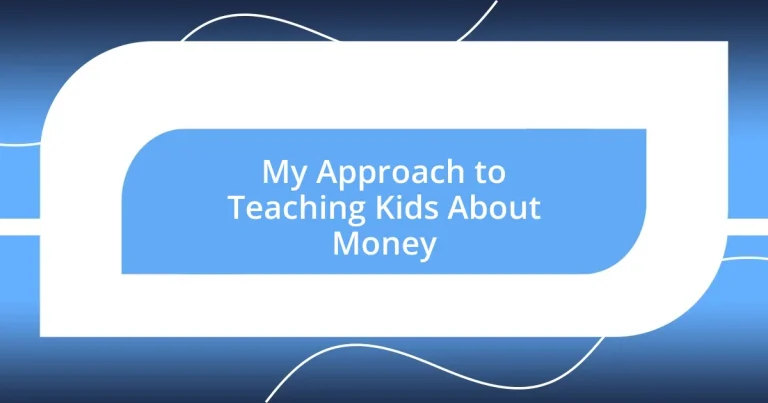Key takeaways:
- Financial literacy is foundational for children, emphasizing the importance of understanding money as a tool for decision-making rather than just a means to acquire things.
- Engaging activities like the “Grocery Store Game” and creating a “Savings Chart” make learning about budgeting and saving enjoyable and relatable for kids.
- Instilling values of giving back fosters empathy and responsibility, reinforcing children’s understanding of the impact of their contributions on their community.

Understanding Financial Literacy Basics
Financial literacy is like a secret toolkit for navigating life’s complexities. I remember the first time I tried to explain budgeting to my niece; her eyes widened when she realized that understanding money wasn’t just about having it, but about deciding what to do with it. Isn’t it fascinating how even simple concepts can seem daunting until we break them down into bite-sized pieces?
When discussing spending and saving, I like to use real-life scenarios. For example, I often ask kids to think about their favorite toy and how much effort it took to save up for it. This not only makes the discussion more relatable but also reinforces the value of money. Don’t you think making financial conversations relevant can ignite a spark of interest in young minds?
As we delve into topics like debt, interest, and investment, I find it helpful to relate them to everyday decisions. Teaching kids that borrowed money isn’t just “free money” but comes with expectations can be quite eye-opening. Have you ever seen the realization on a child’s face when they grasp that concept? It’s those moments that remind me how crucial it is to lay a solid foundation in financial literacy.

Identifying Key Money Concepts
To effectively teach kids about money, it’s essential to identify and convey key concepts that underpin financial literacy. When I first introduced the idea of money as a tool rather than a goal, I noticed how it shifted my children’s mindset. By framing money in this way, they began to question not only how much things cost but why understanding their value was important.
Here are some key money concepts to focus on:
– Understanding Value: Recognizing that value is not just about price but also about utility and satisfaction.
– Budgeting: Learning to plan how to allocate funds toward savings, spending, and sharing.
– Saving vs. Spending: Grasping the importance of delaying gratification for future benefits.
– Debt Awareness: Understanding the implications of borrowing money and the responsibilities that come with it.
– Investment Basics: Introducing the idea that money can grow over time through wise choices.
Recognizing these foundational elements empowers children to make informed choices as they interact with money throughout their lives.

Engaging Activities for Young Learners
Engaging kids in learning about money can be a fun and creative process. One activity I often use is the “Grocery Store Game.” I set up a mock grocery store where kids can shop with play money. They have to budget for their imaginary groceries based on assigned prices. Seeing them deliberate between items and calculate their spending is always a joy. It’s not just about pretending; it teaches them valuable skills like budgeting and decision-making in a playful environment.
Another enjoyable method is creating a “Savings Chart.” I ask kids to design a colorful chart to track their savings towards a desirable item, perhaps a new bike or video game. Each time they save a bit of money, they can add it to their chart. I remember the excitement in my daughter’s eyes as she hit her first milestone and could visualize her progress. It’s remarkable how visual cues can motivate young learners and make financial concepts tangible.
Incorporating stories can be particularly effective. I like to narrate tales where characters face financial challenges, prompting kids to discuss what they would do in those situations. For instance, discussing how a character couldn’t buy something they wanted because they spent their money unwisely invites thoughtful dialogue about making smart choices. I find that these discussions not only engage their critical thinking but also help them relate those lessons to their own lives.
| Activity | Description |
|---|---|
| Grocery Store Game | A mock grocery shopping experience that helps kids learn budgeting techniques with play money. |
| Savings Chart | A visual tool for tracking savings progress towards a desired item, fostering excitement and motivation. |
| Story Time Discussion | Narrating tales with financial dilemmas encourages critical thinking and personal connections to money management. |

Teaching Saving Through Fun Games
Playing games to teach kids about saving can be both exciting and rewarding. One of my favorite activities is the “Save or Spend” challenge, where kids receive a set amount of pretend money and must decide how much to save and how much to spend on different fun items. Watching them weigh their choices makes me think: how often do we adults pause to consider the value of saving versus instant gratification? The look of concentration on their faces is priceless.
Another fun approach I’ve found to be effective is a piggy bank race. Each child personalizes their piggy bank and races to fill it up the fastest. The interesting twist? They have to bail out items they wanted to buy but couldn’t afford, reflecting on their choices along the way. I remember my son’s determination as he watched his friend’s bank fill up. “I want to save more!” he declared, and that moment encouraged a real conversation about the benefits of patience and strategic saving.
I’ve also incorporated board games like “Monopoly” into our family game nights. While we’re rolling dice and trading properties, I take the opportunity to discuss the importance of saving for a rainy day. I’ve found that these casual settings allow the lessons on saving to seep in naturally without feeling forced. Have you ever noticed how kids absorb lessons while playing? It’s like they’re learning life skills while having the time of their lives!

Introducing Budgeting Skills Early
Budgeting skills are best introduced when kids are young. I remember the first time I helped my son create a simple budget for his weekly allowance. We sat down with colorful markers and paper, dividing his money into categories for saving, spending, and giving. Watching his eyes light up as he realized he could strategize about his finances was a moment I cherish. It transformed our approach to money from a mundane topic to an engaging conversation.
I often encourage kids to think of budgeting as a game—something that can be both fun and educational. For instance, we’d turn grocery shopping into a budgeting challenge, where he needed to stick to a set limit for snacks. I’d ask him questions, like, “What if you really want something more expensive? How would you adjust your plan?” It was rewarding to see him problem-solve and make decisions. This approach not only taught him budgeting but also instilled a desire to manage his money wisely.
The emotional connection kids create with budgeting can be powerful. One time, my daughter made a small budget for a school event, deciding between different outfits she wanted to buy. When she couldn’t buy everything on her list, she expressed a mix of disappointment and realization about the importance of prioritizing her wants. Those moments of reflection facilitate deeper understanding—a chance for lessons life typically teaches later, right in the comfort of our home. Have you ever considered how much kids can learn about responsibility when armed with a simple budget? It’s incredible to witness their growth.

Encouraging Smart Spending Choices
Encouraging kids to make smart spending choices can be an enlightening journey. I remember a family trip to the store where my daughter spotted a shiny toy. Instead of buying it immediately, I encouraged her to think about what else she would like in the future. “What if you saved for a few weeks? What could you buy then?” Her eyes sparkled with the possibility, showing me how powerful a little guidance can be in helping them evaluate their wants against their needs. This simple moment turned her impulse into a thoughtful discussion about the lasting joy that saving can bring.
I also find that discussing the concept of trade-offs can be incredibly impactful. One day, while enjoying ice cream, we talked about how enjoying an expensive scoop today might limit their ability to go to the amusement park later. “Do you want that one treat now or an even bigger adventure later?” I asked. It was fascinating to see my son nod in understanding, realizing that wise spending could lead to even greater experiences down the line. Conversations like these not only clarify concepts but also make them feel more invested in their choices.
Sometimes, sharing our own experiences with spending can really resonate with kids. I recall a time when I regretted buying an overpriced gadget that ended up collecting dust. I explained how that choice taught me a valuable lesson about evaluating value versus impulse. “I can help you avoid that mistake!” I told my kids. Their curiosity peaked as they listened to my story, reinforcing that learning from real-life experiences, including our mistakes, can be a powerful tool in guiding them toward smart spending choices. Have you ever shared a money misstep with your child? You might be surprised by how much they absorb, turning your experience into their roadmap to success.

Instilling Values of Giving Back
Instilling the value of giving back in children is a vital life lesson that shapes their character and perspective on the world. I vividly recall when my son decided to donate his allowance to help a local animal shelter. As we walked in together, he gripped the bag of supplies we had picked out, a smile stretching across his face. That moment wasn’t just about charity; it was about connection—understanding how his small contribution could make a real difference. Have you ever watched a child realize their power to affect change? It’s remarkable how it fosters empathy and understanding.
One particular experience stands out to me. We participated in a community clean-up day, and although my daughter initially groaned at the idea, I assured her it would be fun. As we picked up trash together, she began to notice the transformations in our surroundings—how a clean park meant a better place for kids to play. Seeing her enthusiasm grow reminded me that participation is key; when they actively contribute, the values of giving become more meaningful. What kept surprising me was how she began to care deeply about our community, asking how she could do more each time we spoke about our efforts.
Encouraging children to give back also creates a foundation of gratitude. After volunteering, we often sit down for a family dinner, where we share our experiences from the day. One evening, I asked my kids what they were thankful for, and they opened up about the joy they felt helping others. It struck me that these moments of reflection not only nurture their hearts but also instill a sense of responsibility to think beyond themselves. Have you ever seen a child light up when they realize their actions can lead to happiness for others? It’s a priceless gift that lasts a lifetime.














